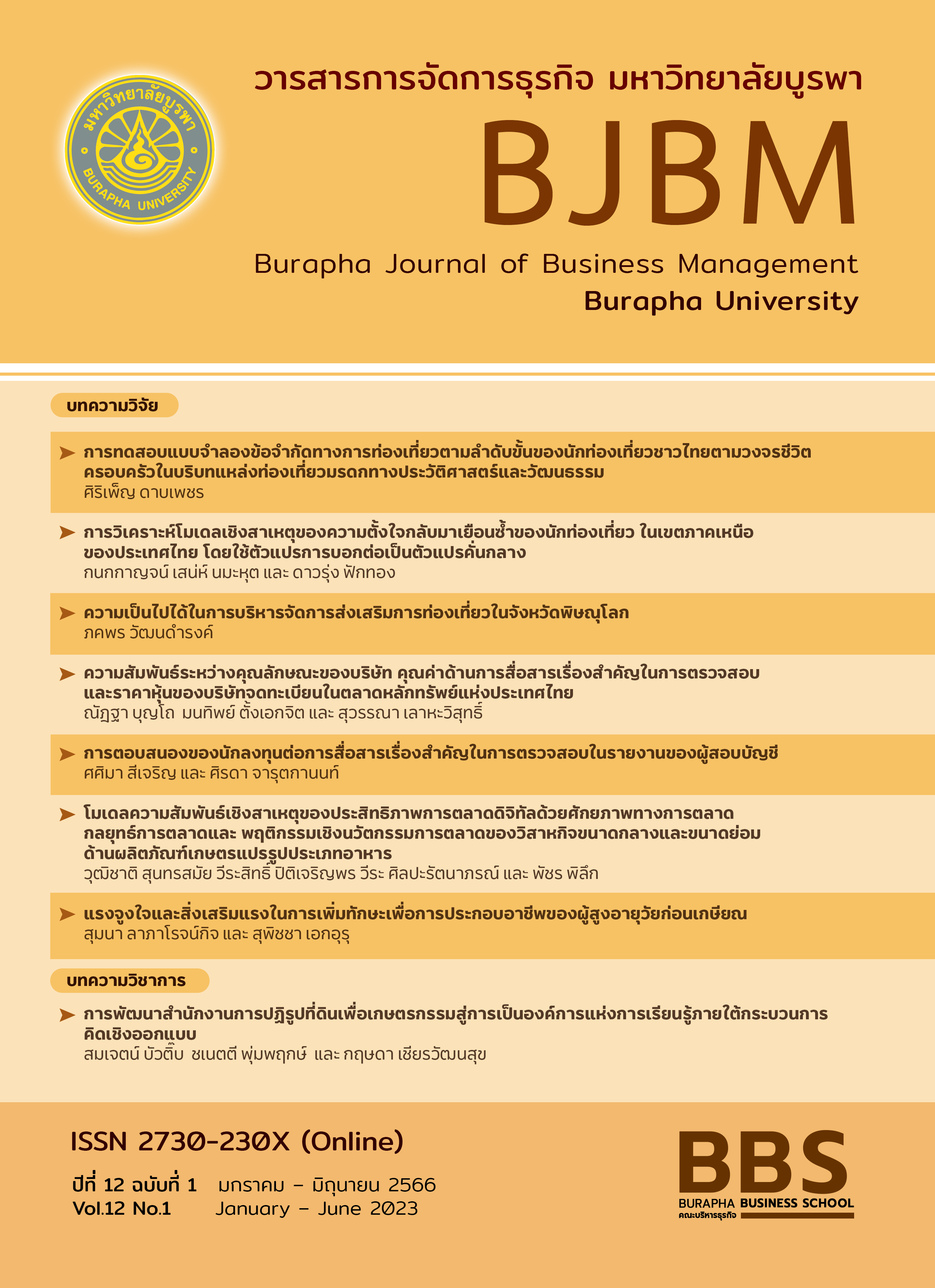การตอบสนองของนักลงทุนต่อการสื่อสารเรื่องสำคัญในการตรวจสอบในรายงานของผู้สอบบัญชี
Main Article Content
บทคัดย่อ
งานวิจัยนี้มีวัตถุประสงค์เพื่อศึกษาการสื่อสารเรื่องสำคัญในการตรวจสอบ และการตอบสนองของนักลงทุนต่อการสื่อสารเรื่องสำคัญในการตรวจสอบทั้งในส่วนของจำนวนเรื่องสำคัญในการตรวจสอบ และรูปแบบการนำเสนอเรื่องสำคัญในการตรวจสอบ กลุ่มตัวอย่างที่ใช้ในการวิจัยคือ บริษัทจดทะเบียนในตลาดหลักทรัพย์แห่งประเทศไทย และตลาดหลักทรัพย์เอ็ม เอ ไอ ในระหว่างปี พ.ศ. 2559 – 2562 งานวิจัยนี้ใช้การวิเคราะห์ความถดถอยเชิงพหุในการทดสอบสมมติฐานผลการวิจัยพบว่า รายงานผู้สอบบัญชีของกลุ่มตัวอย่างส่วนใหญ่แสดงเรื่องสำคัญในการตรวจสอบในรูปแบบพรรณนา จำนวนเรื่องสำคัญในการตรวจสอบที่แสดงในรายงานผู้สอบบัญชีเฉลี่ย 1.86 เรื่อง และประเด็นที่นำมากำหนดเป็นเรื่องสำคัญในการตรวจสอบส่วนใหญ่เป็นเรื่องการรับรู้รายได้ และการด้อยค่าของสินทรัพย์ ผลการวิจัยไม่พบการตอบสนองของนักลงทุนต่อจำนวนและรูปแบบการนำเสนอเรื่องสำคัญในการตรวจสอบของกลุ่มตัวอย่างรวม อย่างไรก็ตามเมื่อนำตัวแปรประเภทของตลาดหลักทรัพย์ที่บริษัทจดทะเบียนมาร่วมพิจารณา ผลวิจัยพบการตอบสนองของนักลงทุนในทิศทางลบต่อจำนวนและรูปแบบการนำเสนอเรื่องสำคัญในการตรวจสอบในรายงานของผู้สอบบัญชีของบริษัทจดทะเบียนในตลาดหลักทรัพย์เอ็ม เอ ไอ
Article Details

อนุญาตภายใต้เงื่อนไข Creative Commons Attribution-NonCommercial-NoDerivatives 4.0 International License.
บทความที่จะตีพิมพ์เพื่อเผยแพร่ในวารสารการจัดการธุรกิจ มหาวิทยาลัยบูรพา จะต้องเป็นบทความที่ไม่เคยได้รับการตีพิมพ์เผยแพร่หรืออยู่ระหว่างการพิจารณาเพื่อตีพิมพ์เผยแพร่ในวารสารอื่น ๆ ทั้งนี้ หากพบว่ามีการละเมิดลิขสิทธิ์ ด้วยข้อคิดเห็นที่ปรากฏและแสดงในเนื้อหาบทความต่าง ๆ ให้ถือว่าเป็นความเห็นและความรับผิดชอบโดยตรงของผู้เขียนบทความนั้น ๆ มิใช่ความเห็นและความรับผิดชอบใด ๆ ของคณะบริหารธุรกิจ มหาวิทยาลัยบูรพา สำหรับในกรณีผู้ประสงค์จะนำข้อความในวารสารการจัดการธุรกิจ มหาวิทยาลัยบูรพา ไปเผยแพร่ต้องได้รับอนุญาตจากกองบรรณาธิการวารสารการจัดการธุรกิจ มหาวิทยาลัยบูรพา ตามกฎหมายว่าด้วยลิขสิทธิ์
เอกสารอ้างอิง
ชาญชัย ตั้งเรือนรัตน์. (2552). การสื่อสารของรายงานของผู้สอบบัญชี: กรณีร่างรายงานของผู้สอบบัญชีแบบใหม่. วารสารวิชาชีพบัญชี, 13(8), 31-53.
ชาญชัย ตั้งเรือนรัตน์. (2560). การใช้รายงานของผู้สอบบัญชีแบบใหม่: ประสบการณ์ปีแรก. วารสารวิชาชีพบัญชี, 13(38), 5-21.
ศศิภา สอิ้งทอง. (2560). ประโยชน์ที่ได้รับจากการรายงานเรื่องสำคัญในการตรวจสอบในรายงานผู้สอบบัญชีของบริษัทที่จดทะเบียนในตลาดหลักทรัพย์แห่งประเทศไทย. งานค้นคว้าอิสระปริญญามหาบัณฑิต, สาขาการบัญชี, คณะพาณิชยศาสตร์และการบัญชี, มหาวิทยาลัยธรรมศาสตร์.
ศิลปพร ศรีจั่นเพชร. (2560). "เรื่องสำคัญในการตรวจสอบ" ในหน้ารายงานผู้สอบบัญชีกับการตอบสนองของตลาดหลักทรัพย์แห่งประเทศไทย. วารสารวิชาชีพบัญชี, 38(6), 22-37.
สภาวิชาชีพบัญชี ในพระบรมราชูปถัมภ์. (2559). มาตรฐานการสอบบัญชีฉบับที่ 701: การสื่อสารเรื่องสำคัญในการตรวจสอบในรายงานของผู้สอบบัญชีรับอนุญาต. กรุงเทพมหานคร: สภาวิชาชีพบัญชี ในพระบรมราชูปถัมภ์.
Altawalbeh, M. A. F., & Alhajaya, M. E. S. (2019). The investors reaction to the disclosure of key audit matters: Empirical evidence from Jordan. International Business Research, 12(3), 50-57.
Bae, K. H., & Jeong, S. W. (2007). The value-relevance of earnings and book value, ownership structure, and business group affiliation: Evidence from Korean Business Groups. Journal of Business Finance & Accounting, 34(5), 740-766.
Bamber, L. S., Barron, O. E., & Stevens, D. E. (2010). Trading volume around earnings announcements and other financial reports: Theory, research design, empirical evidence, and directions for future research. Contemporary Accounting Research, 28(2), 431–471.
Bédard, J., Gonthier-Besacier, N., & Schatt, A. (2018). Consequences of Expanded Audit Reports: Evidence from the Justifications of Assessments in France. A Journal of Practice & Theory, 38(3), 23-45.
Brimble, M., & Hodgson, A. (2007). On the intertemporal value relevance of conventional financial accounting in Australia. Accounting and Finance, 47(4), 599–622.
Boonyanet, W., & Promsen, W. (2019). Key Audit Matters: Just Little Informative Value to Investors in Emerging Markets? Chulalongkorn Business Review, 41(159), 153-183.
Christensen, B. E., Glover, S. M., & Wolfe, C. J. (2014). Do critical audit matter paragraphs in the audit report change nonprofessional investors' decision to invest? Auditing: A Journal of Practice & Theory, 33(4), 71-93.
Cordoş, G. S., & Fülöp, M. T. (2015). Understanding audit reporting changes: introduction of Key Audit Matters. Accounting and Management Information Systems, 14(1), 128-152.
Fakhfakh, M. (2015). The readability of international illustration of auditor's report: An advanced reflection on the compromise between normative principles and linguistic requirements. Journal of Economics, Finance and Administrative Science, 20(38), 21-29.
Gutierrez, E., Minutti-Meza, M., Tatum, K. W., & Vulcheva, M. (2018). Consequences of adopting an expanded auditor’s report in the United Kingdom. Review of Accounting Studies, 23(4), 1543-1587.
Hirst, D. E., & Hopkins, P. E. (1998). Comprehensive Income Reporting and Analysts’ Valuation Judgments. Journal of Accounting Research, 36, 47-75.
Kim, O., & Verrecchia, R. E. (1991).Trading volume and price reactions to public announcements. Journal of Accounting Research, 29(2), 302-321.
Lennox, C. S., Schmidt, J. J., & Thompson, A. M. (2022). Why are expanded audit reports not informative to investors? Evidence from the United Kingdom. Review of Accounting Studies, 2022, 1-36.
Pathirawasam, C. (2013). The Value Relevance of Earnings and Book Value: The Importance of Ownership Concentration and Firm Size. Journal of Competitiveness, 5(2), 98–107.
Rapley, E. T., Robertson, J. C., & Smith, J. L. (2018). The effects of disclosing critical audit matters and auditor tenure on investors’ judgments. Journal of Accounting and Public Policy, 40(1), 73 - 81.
Shrestha, N. (2020). Detecting Multicollinearity in Regression Analysis. American Journal of Applied Mathematics and Statistics, 8, 39–42.
Sirois, L. P., Bédard, J., & Bera, P. (2018). The informational value of key audit matters in the auditor's report: evidence from an eye-tracking study. Accounting Horizons, 32(12), 132-159.


